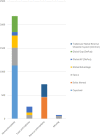Increasing incidence of primary shoulder arthroplasty in Finland - a nationwide registry study
- PMID: 30031390
- PMCID: PMC6054850
- DOI: 10.1186/s12891-018-2150-3
Increasing incidence of primary shoulder arthroplasty in Finland - a nationwide registry study
Abstract
Background: The incidence of shoulder arthroplasties is reportedly increasing and the types of arthroplasty are changing. The purpose of this study was to investigate the incidence of primary shoulder arthroplasty in Finland.
Methods: We analyzed nationwide data from the Finnish Arthroplasty Register (FAR) and the Finnish National Hospital Discharge Register (NHDR) during time period 2004-2015. The primary outcome variable was the incidence of shoulder arthroplasty per 100,000 person-years stratified by age, sex and year of surgery. The secondary outcome variables were surgical indication, arthroplasty type and prosthesis model.
Results: The number of primary shoulder arthroplasties was 7504 (women = 4878, men = 2625). The rate of operations increased from 6 to 15 per 100,000 person-years among men, and 11 to 26 per 100,000 person-years among women. The indication for arthroplasty was osteoarthritis in 56%, acute fracture in 21%, inflammatory arthritis in 13%, and rotator cuff arthropathy in 4% of the cases. Hemiarthroplasties accounted for 66%, total shoulder arthroplasties 8%, and reverse shoulder arthroplasties 12% of the cases, 14% of the cases was missing. During the 12-year study period the incidence of hemiarthroplasties decreased by 23% and the number of total shoulder and reverse shoulder arthroplasty increased by 500 and 4500%, respectively.
Conclusions: The incidence of primary shoulder arthroplasty has increased by 160% during the study period in Finland. The incidence of hemiarthroplasties decreased while total and reverse shoulder arthroplasties increased.
Keywords: Arthroplasty; Finland; Incidence; Shoulder joint.
Conflict of interest statement
Ethics approval and consent to participate
The study was approved by Finland’s National Institute for Health and Wellness (Protocol number: Dnro THL/1743/5.05.00/2014). This study did not require participant consent as the data analyzed was anonymously coded.
Consent for publication
Not applicable.
Competing interests
JNEH, JP, JH and JK have no competing interests; VÄ has received research grants from Turku University Hospital district, Suomen Lääketieteensäätiö and SECEC for other studies.
Publisher’s Note
Springer Nature remains neutral with regard to jurisdictional claims in published maps and institutional affiliations.
Figures





References
-
- Aromaa A, Koskinen S. Terveys ja toimintakyky Suomessa: Terveys 2000 -tutkimuksen perustulokset. Finland: Kansanterveyslaitoksen julkaisuja B: 3/2002. http://urn.fi/URN:ISBN:951-740-262-7. Accessed 19 Feb 2016.
-
- New Zealand Joint Registry, The New Zealand Joint Registry: Sixteen Year Report, January 1999 to December 2014, http://www.nzoa.org.nz/system/files/Web_DH7657_NZJR2014Report_v4_12Nov15... 2015; Accessed 5 May 2015.
-
- Kim SH, Wise BL, Zhang Y, Szabo RM. Increasing incidence of shoulder arthroplasty in the United States. J Bone Joint Surg Am. 2011;93:2249–54. 10.2106/JBJS.J.01994. - PubMed
-
- Australian Orthopaedic Association National Joint Replacement Registry, Annual report from the Australian Joint Replacement Registry. Demographics and outcome of shoulder arthroplasty, Supplementary report https://aoanjrr.sahmri.com/documents/10180/217645/Shoulder%20Arthroplasty 2013.
MeSH terms
LinkOut - more resources
Full Text Sources
Other Literature Sources

